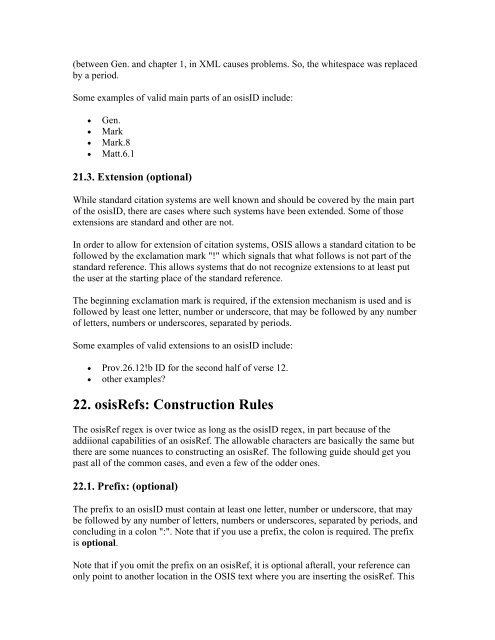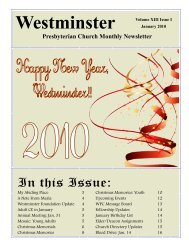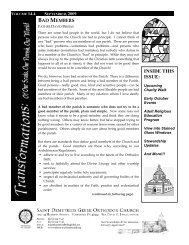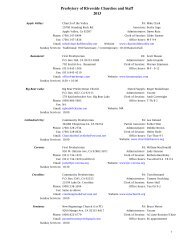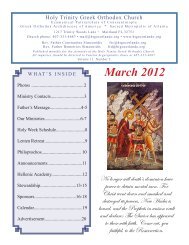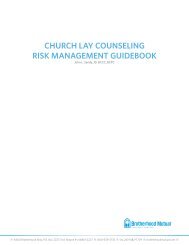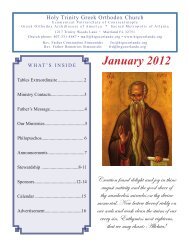OSIS? 2.0.1 User's Manual - Web services are running on AMBIB
OSIS? 2.0.1 User's Manual - Web services are running on AMBIB
OSIS? 2.0.1 User's Manual - Web services are running on AMBIB
You also want an ePaper? Increase the reach of your titles
YUMPU automatically turns print PDFs into web optimized ePapers that Google loves.
(between Gen. and chapter 1, in XML causes problems. So, the whitespace was replaced<br />
by a period.<br />
Some examples of valid main parts of an osisID include:<br />
• Gen.<br />
• Mark<br />
• Mark.8<br />
• Matt.6.1<br />
21.3. Extensi<strong>on</strong> (opti<strong>on</strong>al)<br />
While standard citati<strong>on</strong> systems <str<strong>on</strong>g>are</str<strong>on</strong>g> well known and should be covered by the main part<br />
of the osisID, there <str<strong>on</strong>g>are</str<strong>on</strong>g> cases where such systems have been extended. Some of those<br />
extensi<strong>on</strong>s <str<strong>on</strong>g>are</str<strong>on</strong>g> standard and other <str<strong>on</strong>g>are</str<strong>on</strong>g> not.<br />
In order to allow for extensi<strong>on</strong> of citati<strong>on</strong> systems, <str<strong>on</strong>g>OSIS</str<strong>on</strong>g> allows a standard citati<strong>on</strong> to be<br />
followed by the exclamati<strong>on</strong> mark "!" which signals that what follows is not part of the<br />
standard reference. This allows systems that do not recognize extensi<strong>on</strong>s to at least put<br />
the user at the starting place of the standard reference.<br />
The beginning exclamati<strong>on</strong> mark is required, if the extensi<strong>on</strong> mechanism is used and is<br />
followed by least <strong>on</strong>e letter, number or underscore, that may be followed by any number<br />
of letters, numbers or underscores, separated by periods.<br />
Some examples of valid extensi<strong>on</strong>s to an osisID include:<br />
• Prov.26.12!b ID for the sec<strong>on</strong>d half of verse 12.<br />
• other examples?<br />
22. osisRefs: C<strong>on</strong>structi<strong>on</strong> Rules<br />
The osisRef regex is over twice as l<strong>on</strong>g as the osisID regex, in part because of the<br />
addii<strong>on</strong>al capabilities of an osisRef. The allowable characters <str<strong>on</strong>g>are</str<strong>on</strong>g> basically the same but<br />
there <str<strong>on</strong>g>are</str<strong>on</strong>g> some nuances to c<strong>on</strong>structing an osisRef. The following guide should get you<br />
past all of the comm<strong>on</strong> cases, and even a few of the odder <strong>on</strong>es.<br />
22.1. Prefix: (opti<strong>on</strong>al)<br />
The prefix to an osisID must c<strong>on</strong>tain at least <strong>on</strong>e letter, number or underscore, that may<br />
be followed by any number of letters, numbers or underscores, separated by periods, and<br />
c<strong>on</strong>cluding in a col<strong>on</strong> ":". Note that if you use a prefix, the col<strong>on</strong> is required. The prefix<br />
is opti<strong>on</strong>al.<br />
Note that if you omit the prefix <strong>on</strong> an osisRef, it is opti<strong>on</strong>al afterall, your reference can<br />
<strong>on</strong>ly point to another locati<strong>on</strong> in the <str<strong>on</strong>g>OSIS</str<strong>on</strong>g> text where you <str<strong>on</strong>g>are</str<strong>on</strong>g> inserting the osisRef. This


